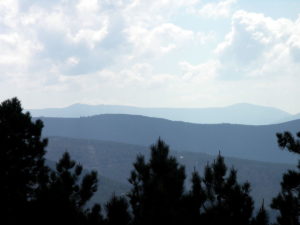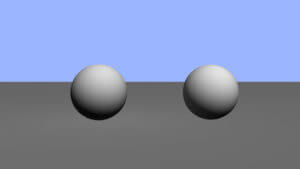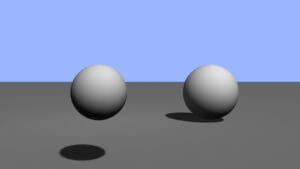Since the dawn of art, mankind has struggled with depicting a basic function of vision: depth. Ancient cave drawings, Egyptian hieroglyphs, and even Medieval paintings depicted the world as flat. Attempts at capturing the idea of 3D space in a 2D medium were difficult. But by the Renaissance, the most successful depictions of depth were finally exhibited.
Film is not much different. Whether animated or live-action, film is the same as painting or photography but one that deliberately changes over time. Therefore, the same rules painters of old used to show depth still apply today. And the surprising part is, a lot of it is done with lighting.

eXamine Your Z-depth
What’s in a name anyway? 3D space, depth, Z? Simply put, these terms are interchangeable, but I like to think of it like this:
3D space specifically deals with all the dimensions of real or simulated 3 dimensional environments.
Z-depth is the mathematical language used to depict a location going backward or forwards in a space as opposed to X, which goes from left to right, and Y which goes up and down.
When we look at a flattened 2D image, such as a picture or a video, we lose 3D space through both Stereoscopy and Ocular Focusing. In other words, both eyes see the exact same thing, and each eye has a flat image to focus on.
Stereoscopy is when each eye sees a slightly different image and the brain can put those images together into a 3D image.
Ocular Focusing is our ability to focus on objects within a 3D space with each eye. In order to bring back the effect of 3D space, we need to mimic the depth cues we naturally find in real-world environments.
So, what are these cues?
- Atmospheric Perspective
- Changes in color
- Light and Shadow positions
- Focus
- Linear Perspective
- Relative Size
- Overlapping forms
- Motion parallax
- Stereo Imagery
Now I won’t talk in depth about all of these in this post, but I will go over them briefly. However, even with stereoscopic 3D glasses, we still can’t quite achieve Ocular Focusing. In fact, this may only be achievable with some future technology like holograms.
Atmospheric Perspective
Atmospheric Perspective is using color and light to show depth in a large environment, such as a landscape. In short, it is the haze you see in the distance when looking out at something like the Grand Canyon.
What you see are tiny particles in the air, like water and dust, which are invisible up close but over great distances are capable of obscuring the image.
To achieve this effect, artists desaturate objects in the distance, lower the contrast, and tint the color. This can also be used more heavily to show pollution, sandstorms, and fog.
It is a common practice in film to exaggerate this effect even in smaller spaces by adding fog and mist to scenes to help push the background back visually.
Change In Color
Change in Color is just a way to use color to separate the foreground, midground, and background planes to create the illusion of depth.
This isn’t used much in film or animation, but it often mimics atmospheric perspective, only with different colors. For example, in this painting, the foreground is lighter than the background. It’s the opposite of what you’d expect in atmospheric perspective, and yet we can still sense the depth of the landscape.
Shadow and Light Positions
Shadow and Light Positions are a strong indicator of 3D space.
When two objects of different sizes are side-by-side on the screen, we often use the position of the shadow and the light to figure out their relation to each other and the environment. That way we can tell if it is a small floating object or a large object far away. This is very important in animation.
Often times, untrained animators miss placing objects on the ground and just leave them floating in mid-air. This is because they look like they are on the ground. Once a light and shadow are applied, this effect becomes apparent.
Focus
Focus, or Depth of Field, is a technique used in photography to blur out objects that are farther away or very close.
This gives an idea of how far away something is based on how blurred out it is. Even in hand-drawn animation we use this effect on our backgrounds to help sell the idea of depth.
The artist can choose to change the focus, called racking focus or pulling focus, in order to draw the eye of the viewer from one subject to another.

Linear Perspective
Linear Perspective is something more commonly used in painting and drawing since it occurs naturally in photography.
It is the use of lines and edges of objects to depict perspective distortion and thus the illusion of depth. This is one of the earliest perspective discoveries and can still stump budding artists when they plot out complicated scene layouts. Luckily computers and physics can do this for us.

Relative Size
Relative Size shows the idea that objects that are farther away but similar in height or size are smaller in frame. We know all these cars are the same size, even though they are 3 different sizes in the picture. Our brains just tell us that the smallest is farther away.

Overlapping Forms
Overlapping Forms is the idea that one object in front of another will help determine which one is closer. This is used all the time in every example I have provided. The cars above overlap, the people overlap each other, the teacup overlaps part of the table, etc.
Motion Parallax
Motion Parallax is the effect of objects closer to you moving faster past you than objects farther away.
Imagine looking out a car window while driving down the highway. The light poles will zoom by much quicker than the trees behind them, and those would move past faster than the mountain in the distance. The relative speed of these objects directly correlates with their distance to you.
Stereo Imagery
Finally, Stereo Imagery is a technique used to create 2 different images with many other depth cues in them that are taken or drawn from slightly different perspectives.
People have taken pictures using special cameras to capture the effect of depth for stereo imagery for a century. Brian May of Queen released several books with Victorian-era stereoscopic photographs, and even modern ones from his time in Queen.
The oldest known accidental stereo imagery may actually come from the Leonardo Da Vinci and the Mona Lisa! Another artist painted the same subject as Da Vinci from a slightly different perspective, and the result is a near stereo image between the two paintings.

Putting Things Into Perspective
When you think about it, no matter how complicated or advanced the techniques you use are, no matter how amazing the 3D effects are in that IMAX theater, all you are looking at is a 2D plane. And yet, even a drawing or painting, or an animated film, have the ability to trick your mind into thinking you are seeing depth.
Lighting and Color greatly enhance this effect, and understanding how it works and what all the tools you have available to you are can help you make a better, deeper image.





